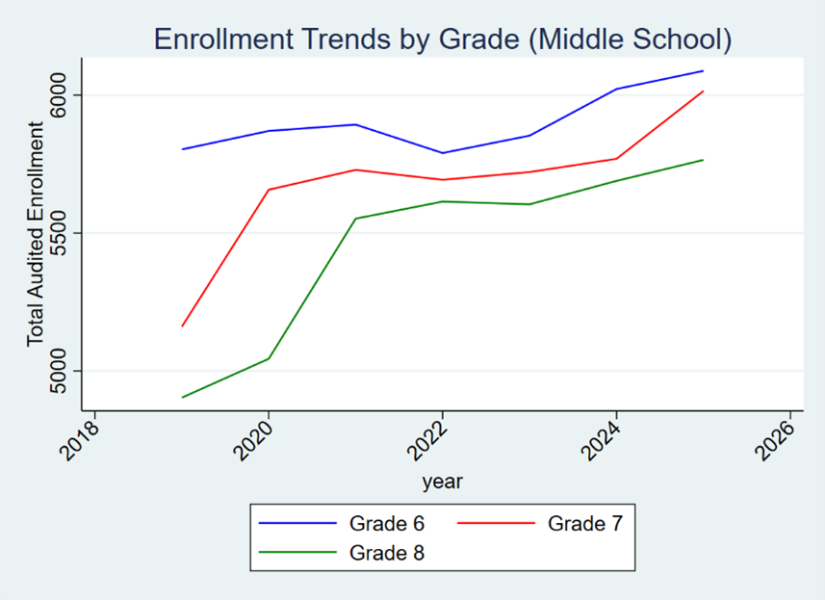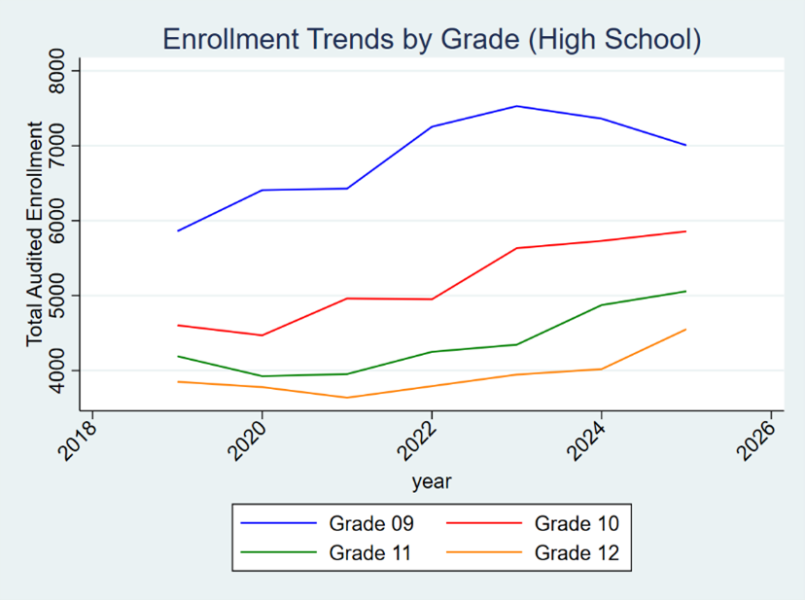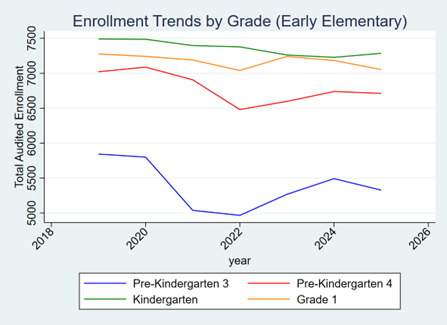Over the past seven years, the District has seen notable shifts in public school enrollment patterns across its public and public charter schools. These trends are likely due to changing demographics, community preferences, high mobility between neighboring metropolitan areas, and external influences, such as the COVID-19 pandemic. Through the 2019-20 school year (SY2019-20) enrollment in DC schools saw consistent growth, driven particularly by increased investments in public education, improved charter school options, and a growing population of young families in the district. The 2020-21 school year marked a decline in enrollment, particularly in the early childhood grades (Pre-K and Kindergarten). Many families opted for alternative schooling options, including homeschooling or private schools during the height of the pandemic (Homeschooling on the Rise During COVID-19 Pandemic). Post-pandemic, enrollment began recovering in SY2021-22 but has yet to fully return to pre-pandemic levels for all grades. Although, overall enrollment has increased steadily from SY2022-23 through SY2024-25, there are variations in growth by grade. To unmask and understand this occurrence, it is important to do grade-level analyses and assess which grades have increased/decreased year over year.

Overall, high school enrollment has shown the most resilience. Comparing SY2018-19 to SY2024-25, grades with the largest increases in enrollment were Grade 10 (1,254), Grade 09 (1,146), Grade 11 (867), and Grade 8 (862). This trend could be explained by OSSE’s sizable investments in postsecondary education programming as well as Career and Technical Education (CTE). OSSE investments include the federal $21 million Gaining Early Awareness and Readiness for Undergraduate Programs (GEAR UP) grant, opening of the Advanced Technical Center (ATC), Advanced Internship Program (AIP) and Career Readiness Internships (CRI), and the continuation of the DC Tuition Assistance Grant (DCTAG) and Mayor’s Scholars programs. Lastly, we have seen a large increase in enrollment for adult students (870). Adult education programs are dedicated to District residents who want to re-engage the educational process, whether this is to earn a General Educational Development (GED) certificate or to enroll in Postsecondary/Career Education/Training programs. The demand for adult services could be spurred on by the increased demand for workforce skills, career advancement, and lifelong learning. For example, the Division of Early Learning (DEL) made substantial investments in credential attainment for early childhood teachers/leaders. Adult programs also are more likely to offer flexible learning options, such as online courses, which makes it easier for adults to integrate into their daily lives.


Conversely, grades with the steepest decrease in enrollment were Pre-K 3 (-516), Pre-K 4 (-309), Grade 1 (-222), and Kindergarten (-205). The large fluctuations in early elementary enrollment can be explained by historically low birthrates in the district. Birthrates have consistently declined since the 1990s, except from 2006 to 2016. This increase in births during this period helps account for some of the larger increases in middle school and high school enrollment. Otherwise, the number of births has decreased per year. Given this, we should expect these numbers to decrease in a succinct pattern with birth rates year over year.

Learn More
You can read more about enrollment in our annual Enrollment Audit Reports. The SY2024-25 report is available here; past reports are all linked in the Enrollment section of our Data and Reports page. The underlying data files are available here.


